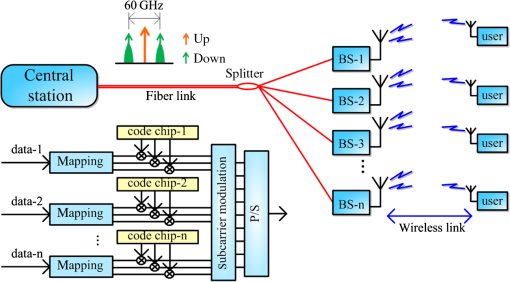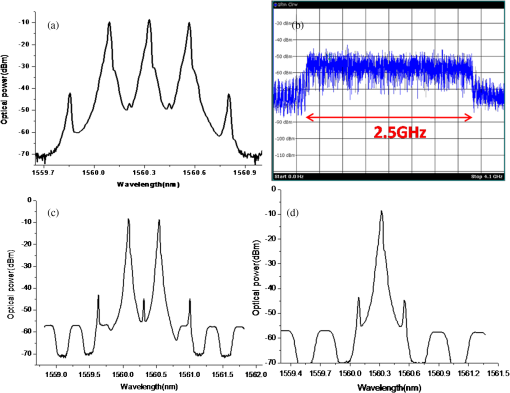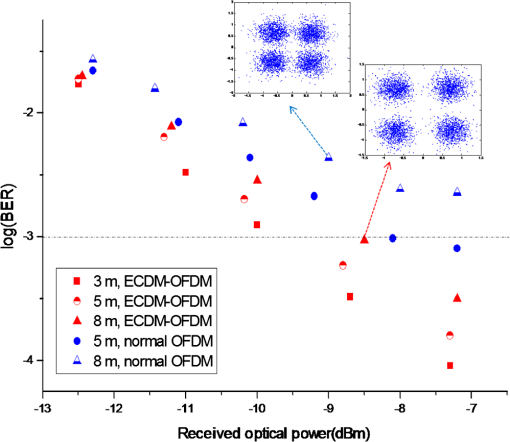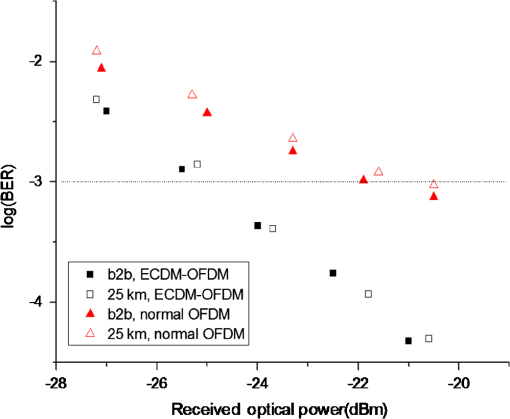|
|
1.IntroductionThe breath-taking growth of wireless and mobile communications has fueled renewed interest in the development of various architectures and technologies that offer an enhanced bandwidth and mobility. The radio-over-fiber (ROF) system, which distributes RF signals from a central office (CO) to the base station (BS) over an optical fiber, has become a promising technology to provide high throughput wireless and wired signals.1–4 In particular, an ROF system centered at 60-GHz band or higher is necessary to provide high capacity wireless links because it offer Gigahertz of available bandwidth. The wide bandwidth will lead to channel-wide nonuniformity such as group delay and fading effect.5 Orthogonal frequency division multiplexing (OFDM) technology, which has been widely utilized in current wireless communication, has become more and more popular in an ROF system due to its high spectral efficiency and resistance to fiber dispersion and fading effect.6–8 Moreover, the uneven channel response of a 60-GHz ROF system can be compensated by a simple digital equalization. Usually, both the optical frequency multiplication method and the scheme of a centralized light source have been employed for bidirectional OFDM-ROF links, which could reduce the cost and complexity of the system.9,10 However, the higher carrier frequency of 60 GHz will lead to a significantly higher loss, resulting in a limited cell radius especially for hotspot places such as airports and conference halls. Although the wireless link can be extended through increasing the transmitted signal power, the RF power is restricted due to the high peak to average power ratio (PAPR) of the OFDM signal. Additionally, a high RF power might be harmful to the human body. Electrical code division multiplexing (ECDM) technology has many attractive advantages such as high code gain and low interference noise between different subscribers.11 It can be utilized to improve the sensitivity of the receiver and to increase the distance of the wireless link. For an upstream OFDM signal, it would suffer a lot due to the optical beating interference (OBI) noise at the CO. The ECDM technology can also be employed to reduce the interference between user channels. In this paper, we propose a new 60-GHz ROF system based on ECDM-OFDM modulation. Compared with a normal OFDM-ROF system, it can extend the distance of a wireless link due to the code gain. It can also suppress the interference between different base stations (BSs) in a wavelength-based colorless upstream link. A ECDM-OFDM ROF system is successfully demonstrated over a 25-km fiber and 8-m air-link in the experiment. 2.System ConfigurationThe proposed configuration of an ECDM-OFDM-based ROF system is illustrated in Fig. 1. In this scheme, a couple of optical carriers spaced at 60 GHz serve as the millimeter-wave (mm-wave), which is shown as green arrows in Fig. 1. The mm-wave can be generated by the optical carrier suppression method. The central blank carrier is reserved for the upstream signal. The aggregated data at the central station (CS) are first mapped into quadrature amplitude modulation symbols, and then assigned with dedicated code chips and OFDM subcarriers. The BSs share the total bandwidth of the OFDM signal, and the spectrum spreading by code chips is executed accompanying with the subcarrier modulation of the OFDM symbol in the electrical domain. At the BS, the ECDM-OFDM RF signals at 60 GHz can be generated by optical beating in a photodiode (PD). The generated RF signals are transmitted out to the subscribers through an air-link, and the central blank carrier is modulated by the upstream ECDM-OFDM signals. Fig. 1Schematic configuration of the electrical code divided multiplexing orthogonal frequency division multiplexing (ECDM-OFDM) based radio-over-fiber (ROF) system (BS: base station).  The ’th sample of the baseband ECDM-OFDM signal can be expressed as where is the index of the OFDM subcarriers, is the index of the BS, is the total number of subcarriers, and are the in-phase and quadrature components of the symbols of -th BS, is the time duration of each sample, and is the code chip for the ’th BS which is satisfied withHere is a constant number proportional to the code gain. A longer code chip would result in higher code gain. The optical ECDM-OFDM ROF signal can be expressed as where is the optical central frequency, is the heterodyning frequency, is the amplitude of the optical carrier and is the modulation index. The linearity of the optical modulator is important for the OFDM signal due to its high PAPR. In the following experiment, we have executed clipping for an OFDM signal and adopted modulator with a large linear work area, which could suppress the nonlinearity at the optical modulation. At the BS, the square-law photo-detector acts as an envelope detector and the photocurrent with ignorance of the double frequency can be represented byHere is the responsivity of the detector. The first part is the baseband signal which will not be transmitted out and the second part is the ECDM-OFDM RF signal. The current of the RF signal can be written as From Eq. (5), we can see that the intersubcarrier interference (ISI) is the main noise. It is caused by optical sideband and OFDM subcarriers around the other sideband in a square-law PD, which would degrade the mm-wave OFDM signal. There, we assume , and , therefore, the down-converted signal at the BS can be expressed as Here is the phase noise of the local oscillator (LO) and . In Eq. (6), the DC component can be removed by DC blocking. For the ’th BS, it will extract data with a dedicated code chip , which can be expressed as The first part of Eq. (7) is the desired signal and the second part is the ISI term. In normal OFDM, the ISI term cannot be removed and remains as noise for the downstream signal. However, this term is suppressed after using ECDM-OFDM. Due to the correlation gain of the code chip, the interference from the other BSs and the signal-to-noise (SNR) can be improved to increase the distance of the wireless link. 3.Experiment and ResultsFigure 2 depicts the experimental setup for the bidirectional ECDM-OFDM ROF system at 60-GHz band. The experiment is carried out in the laboratory. The wavelength of a distributed feed back laser at the CS is 1560.32 nm. A Mach–Zehnder modulator (MZM) and a cascaded 25-GHz interleaver (IL) are employed to generate the mm-wave carrier while providing the light source for the upstream signal. The MZM is driven by a radio frequency (RF) source at 30 GHz. The optical spectrum is shown in Fig. 3(a). The mm-wave carrier is modulated by an intensity modulator (IM), which is driven by the downstream ECDM-OFDM signal. In our experiment, the ECDM-OFDM signal is generated offline by MATLAB®. We adopt quadrature phase shift keying mapping for the bit stream data and the Walsh code chip is a 16 bit-length, which could theoretically provide a 12-dB gain. The total number of OFDM subcarriers is 256 where 8 subcarriers are unfilled and the signal is upconverted by digital I-Q modulation to 2.1 GHz. The length of the cyclic prefix is and a training sequence is added every 60-OFDM symbols. An arbitrary waveform generator (AWG7122B) with a sample rate and 8 bits resolution is employed to execute the D/A conversion, which produces a data rate of occupying a 2.5-GHz bandwidth. The signal from the AWG gets a of 500 mV and the electrical spectrum is shown in Fig. 3(b). The output signal is amplified by an electrical amplifier with a 16-dB gain and then used to drive the MZM. The measured error vector magnitude of the amplified signal is about 10%. The modulated ECDM-OFDM ROF signal is combined with the central blank carrier by a 3-dB optical coupler. The combined signal is amplified by a commercial Er-doped fiber amplifier (EDFA) before being launched into the 25-km single-mode fiber. The EDFA has a noise figure of 4.2 dB and the measured optical signal-to-noise ratio (OSNR) is about 30.5 dB with a bandwidth of 0.1 nm for the sideband signal. Fig. 3Spectra at corresponding points in Fig. 2: (a) after the MZM at CS; (b) electrical ECDM-OFDM signal; (c) and (d) after the IL at the BS (optical resolution: 0.01 nm).  At the BS, a 25-GHz IL is used to separate the ECDM-OFDM ROF signal and the central blank carrier, and the optical spectra are shown in Figs. 3(c) and 3(d). The optical ROF signal is detected by a 67-GHz PD. The generated ECDM-OFDM RF signal at 60 GHz is amplified by a low noise electrical amplifier (EA) with a 35-dB gain and then sent into the air-link through a standard 20-dBi antenna. After air transmission, the RF signal is received by another antenna and downconverted by an RF clock with a frequency of 60 GHz. The 60-GHz LO is produced by a frequency multiplexer with a 30-GHz clock. After being filtered by a 3.9 GHz low pass filter, the obtained ECDM-OFDM signal is captured by a real-time digital scope with a sample rate and 8 bits resolution. Offline processing is carried out to demodulate the ECDM-OFDM signal. Figure 4 compares the measured bit error ratio (BER) curves of the ECDM-OFDM signal and normal OFDM signal after transmission over different air-link distances. The two signals have the same subcarriers and mapping format. For the ECDM-OFDM signal, a received optical power of at least is needed to achieve a BER of . The corresponding SNR is about 13 dB for the ECDM-OFDM radio signal. However, the BER of the normal OFDM signal with a 5-m air-link seems saturated at an error floor of . When the wireless distance extends to 8 m, the BER of the normal OFDM signal is beyond the forward error correction limit of . The constellations are also shown as insets in Fig. 4. For the upstream link, the central blank carrier serves as the light source, which can simplify the BS and reduce the cost. The same ECDM-OFDM signal modulation is adopted for the upstream signal, and the two BSs share the same OFDM subcarriers. Because the improvement of wireless distance has been demonstrated in the downstream link, we mainly focus on the mitigation of OBI noise for the upstream signal. The signal is directly modulated onto the central blank carrier without a wireless channel. Because the observed performances are almost the same for the two upstream signals, we have taken one signal for analysis. The measured BER curves are illustrated in Fig. 5. It can be seen that the performance of the upstream signal is better than that of the downstream signal. Although the quality of the optical carrier is worse than that of the downstream signal, there is no wireless channel and the dispersion influence can be ignored for an ECDM-OFDM signal with the additional 25-km fiber length. Furthermore, there is a pre-EDFA at the CS for the upstream signal. The power penalties for both the ECDM-OFDM and normal OFDM signals are less than 0.2 dB after transmission. The required SNR at BER of is about 11.5 dB for the upstream signal. Compared with the ECDM-OFDM signal, the BER of the normal OFDM signal is deteriorated due to the OBI noise. The received sensitivity is improved by about 3.7 dB at a BER of after ECDM-OFDM modulation was adopted. As the number of BS increases, the BER deterioration would be more severe. The ECDM-OFDM is easy to implement into the ROF access system using convenient DSP technology. It provides a further wireless transmission distance and mitigates the OBI noise without any channel estimation algorithm, which can reduce the cost for future ROF access. The received sensitivity can be improved by ECDM, which endows the system with more subscribers under the same transmitted power. Besides, it can be well merged with wireless communication based on ECDM. 4.ConclusionThis paper proposed and experimentally demonstrated an ECDM-OFDM-based ROF system over a 25-km fiber and 8-m wireless distance at 60 GHz. Compared with a normal OFDM signal, the wireless distance of the ECDM-OFDM signal has been extended 3 m with the same transmitted power. For the upstream signal, the ECDM-OFDM signal shows a better performance against OBI noise, which is attributed to the code gain. The experimental results underscore the potential of ECDM-OFDM in application for ROF systems. AcknowledgmentsThe financial supports from National High Technology 863 Program of China (No. 2012AA011304), National NSFC (No. 61307086/61205066/61275074/61475024), Beijing Nova Program (No. Z141101001814048) and Beijing Excellent Ph.D. Thesis Guidance Foundation (No. 20121001302) and Fundamental Research Funds for the Central Universities (Grant no. 2014RC0203) are gratefully acknowledged. The project is also supported by the Fund of State Key Laboratory of IPOC (BUPT) and Key Lab of OFS&C (UESTC), Ministry of Education. ReferencesY.-T. Hsuehet al.,
“A novel full-duplex test-bed demonstration of converged all-band 60-GHz radio-over-fiber access architecture,”
in Proc. Optical Fiber Communication Conf. 12,
(2012). Google Scholar
I. Gasulla1J. Capmany,
“Phase-modulated radio over fiber multimode links,”
Opt. Express, 20 11710
–11717
(2012). http://dx.doi.org/10.1364/OE.20.011710 OPEXFF 1094-4087 Google Scholar
Q. Zhanget al.,
“Enabled scalable and privacy wavelength division multiplexing-radio over fiber system based on optical virtual private networks,”
Opt. Eng., 53 066105
(2014). http://dx.doi.org/10.1117/1.OE.53.6.066105 OPEGAR 0091-3286 Google Scholar
C.-C. Weiet al.,
“Adaptively modulated OFDM ROF signals at 60 GHz over long-reach 100-km transmission systems employing phase noise suppression,”
Photon. Technol. Lett., 24 49
–51
(2012). IPTLEL 1041-1135 Google Scholar
A. Ng’omaet al.,
“Data throughput tripling by feed-forward equalization and photonic QPSK in a 7 Gbps single-carrier ROF link at 60 GHz,”
in Proc. Int. Topical Meeting on Microwave Photonics’08,
213
–216
(2008). Google Scholar
A. Caballeroet al.,
“High-capacity 60 GHz and 75–110 GHz band links employing all-optical OFDM generation and digital coherent detection,”
J. Lightw. Technol., 30 147
–155
(2012). http://dx.doi.org/10.1109/JLT.2011.2177637 JLTEDG 0733-8724 Google Scholar
O. OmomukuyoM. P. ThakurJ. E. Mitchell,
“Simple 60-GHz MB-OFDM ultrawideband ROF system based on remote heterodyning,”
Photon. Technol. Lett., 25 268
–271
(2013). http://dx.doi.org/10.1109/LPT.2012.2234735 IPTLEL 1041-1135 Google Scholar
Y. Liet al.,
“Experimental implementation of an all-optical OFDM system based on time lens,”
Opt. Commun., 284 3983
–3989
(2011). http://dx.doi.org/10.1016/j.optcom.2011.04.021 OPCOB8 0030-4018 Google Scholar
C.-H. Changet al.,
“Simplified radio-over-fiber transport systems with a low-cost multiband light source,”
Opt. Lett., 35 4021
–4023
(2010). http://dx.doi.org/10.1364/OL.35.004021 OPLEDP 0146-9592 Google Scholar
C.-H. Yehet al.,
“Using a 1.2 GHz bandwidth reflective semiconductor optical amplifier with seeding light by 64-quadrature amplitude modulation orthogonal frequency division multiplexing modulation to achieve a upstream rate in long-reach passive optical network access,”
Opt. Eng., 51 015004
(2012). http://dx.doi.org/10.1117/1.OE.51.1.015004 OPEGAR 0091-3286 Google Scholar
Y. Kotaniet al.,
“Demonstration of 1.25 Gb / s, x, 8-channels ECDM using eight-chip electrical coding,”
Photon. Technol. Lett., 22 875
–877
(2010). http://dx.doi.org/10.1109/LPT.2010.2047010 IPTLEL 1041-1135 Google Scholar
BiographyLijia Zhang is an associate professor at the Beijing University of Posts and Telecommunications (BUPT) and member of the State Key Laboratory of Information Photonics and Optical Communications at BUPT. She received her BS and PhD degrees from the School of Electric and Engineering, BUPT, Beijing, China, in 2007 and 2011. Her current research interests include optical communication and all-optical networks. Bo Liu is a lecturer at BUPT and a member of the State Key Laboratory of Information Photonics and Optical Communications at BUPT. He received his PhD degree from BUPT in 2013. His research interests include broadband optical communications and optical signal processing. Xiangjun Xin received his PhD degree from BUPT, China, in 2004. Currently, he is a professor of the School of Electric Engineering and a member of the State Key Laboratory of Information Photonics and Optical Communications at BUPT. His main research interests include optical transmission technologies, optical sensors, and all-optical networks. Within this area, he has published more than 80 journal and conference papers. |




